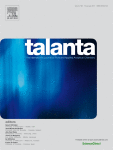Ver ítem
- xmlui.general.dspace_homeCentros Regionales y EEAsCentro Regional Entre RíosEEA ConcordiaArtículos científicosxmlui.ArtifactBrowser.ItemViewer.trail
- Inicio
- Centros Regionales y EEAs
- Centro Regional Entre Ríos
- EEA Concordia
- Artículos científicos
- Ver ítem
Multiresidue method for trace pesticide analysis in honeybee wax comb by GC-QqQ-MS
Resumen
The aim of this analytical study is to develop an improved multi-residue methodology of high sensitivity and expanded scope for pesticide residue analysis in honeybee wax combs. The method was validated for 160 pesticide residues (including acaricides, insecticides, fungicides and herbicides) gas chromatography amenable and covering a wide variety of polarity and chemical structure. This method of analysis applied gas chromatography coupled to a triple
[ver mas...]
The aim of this analytical study is to develop an improved multi-residue methodology of high sensitivity and expanded scope for pesticide residue analysis in honeybee wax combs. The method was validated for 160 pesticide residues (including acaricides, insecticides, fungicides and herbicides) gas chromatography amenable and covering a wide variety of polarity and chemical structure. This method of analysis applied gas chromatography coupled to a triple quadrupole mass spectrometer for the quantitative analysis of pesticide residues. The extraction procedure applied was based QuEChERs method allowing acceptable recoveries for most of the pesticides (98%), within the range 60–120% with an associated precision (RSD) <20%, at concentration levels of MQL of 10 µg kg−1 for all pesticides with the exception of 3,5-dichloroaniline and chlordane (20 µg kg−1). The expanded uncertainty of the results was ±35% on average (coverage factor k=2 for a confidence level of 95%). The chromatographic multi-residue method was applied to determine levels of pesticide residues in 50 honeybee wax comb samples randomly collected from different apiaries in Spain. A total of 32 pesticide residues (14 insecticides/acaricides, 10 insecticides, 6 fungicides and 2 herbicides) were detected in the samples. The highest pesticide concentrations were found for those with insecticide-acaricide activity like acrinathrin, chlorfenvinphos, coumaphos and fluvalinate-tau, some of them are mainly applied in apiculture for controlling the honeybee parasite Varroa destructor. The total load of pesticide residues ranged from 69 to 1000 µg kg−1 for 40% of the analysed samples, 22% contained pesticide residues in the ranges of 1000–2000 µg kg−1, 24% between 2000 and 5000 µg kg−1 and 14% of the samples contained residues between 5000 and 9557 µg kg−1.
[Cerrar]

Autor
Gil García, M.D.;
Uclés, Samanta;
Lozano Fernández, A.B.;
Sosa, Alexis Lionel;
Rodríguez Fernández-Alba, Amadeo;
Fuente
Talanta 163 : 54-64 (January 2017)
Fecha
2017-01-15
ISSN
0039-9140
Formato
pdf
Tipo de documento
artículo
Palabras Claves
Derechos de acceso
Restringido
 Excepto donde se diga explicitamente, este item se publica bajo la siguiente descripción: Creative Commons Attribution-NonCommercial-ShareAlike 2.5 Unported (CC BY-NC-SA 2.5)
Excepto donde se diga explicitamente, este item se publica bajo la siguiente descripción: Creative Commons Attribution-NonCommercial-ShareAlike 2.5 Unported (CC BY-NC-SA 2.5)

